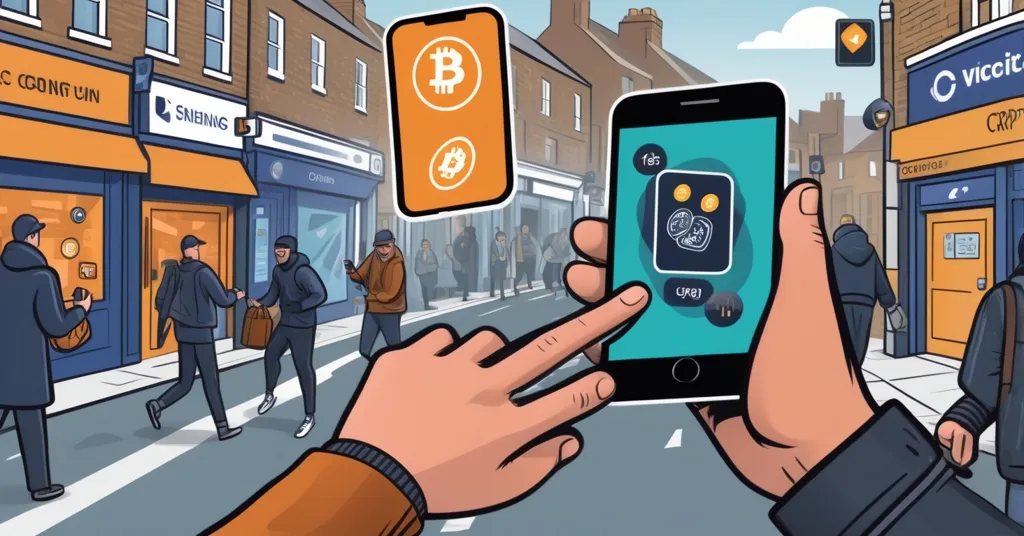Cryptomugging Wave Hits UK: Investors Lose Millions to Smartphone Thefts

New Wave of “Cryptomugging” Hits UK: Investors Lose Millions
In a disturbing trend sweeping the UK, criminals are targeting cryptocurrency investors through a method dubbed “cryptomugging,” where smartphones are snatched to access crypto apps. Toby Atkinson, who turned a £100 investment into over a million pounds, was coerced into transferring £750,000. Similarly, Sam Kelly lost a five-figure sum despite having security measures enabled.
- Cryptomugging: A new crime targeting crypto investors.
- Significant losses: Toby Atkinson loses £750,000, Sam Kelly a five-figure sum.
- Security vulnerabilities: Cold storage and app security settings compromised.
Cryptomugging is a type of theft where robbers steal smartphones to access crypto apps—mobile applications that allow users to store, send, and receive cryptocurrencies—and pilfer digital assets. This alarming trend reflects the growing mainstream adoption of cryptocurrencies and the associated risks.
Toby Atkinson’s story is a stark reminder of these risks. Atkinson typically used cold storage—storing cryptocurrencies offline on a device not connected to the internet, which adds an extra layer of security—but had his crypto on his phone to make a house deposit. This decision cost him dearly. “It’s not just a case of money, but everything I hold private that was stored on my phone. I felt physically and emotionally assaulted,” he shared, highlighting the deep personal impact of such crimes.
Sam Kelly, on the other hand, had security settings enabled but was still compromised. The thieves managed to access his funds, possibly using passwords stored elsewhere on his phone. Despite the setback, Kelly managed to recover over half of his lost funds through complaints to the Financial Ombudsman Service and the involved companies. Atkinson, however, was not as fortunate, unable to recover his funds due to the nature of his transactions.
The vulnerability of crypto apps compared to traditional banking systems is evident. David Gerard, author of Attack of the 50 Foot Blockchain, puts it bluntly:
Unlike online bank accounts, which are difficult to enter, crypto apps are like carrying around little lumps of gold… It is so stupidly brittle. These are not reversible transactions. Would you go down to the pub with £10,000 cash in your pocket? Probably not. You need to treat crypto like a big pile of money.
The police’s response to these incidents has been met with frustration from victims. Yet, according to Phil Ariss, former Crypto Lead for the NPCC Cybercrime Programme and Director of UK Public Sector Relations for TRM Labs, law enforcement has tools at their disposal to track stolen crypto assets. “As soon as thieves attempt to cash out, we can track them,” Ariss explained, offering a glimmer of hope in the fight against these digital heists. These tools include blockchain analysis software that can trace the flow of stolen funds.
With approximately 225 phones stolen daily in Britain, the focus on crypto apps is a worrying trend. The UK has seen a record £306 million lost to crypto scams in 2023, a 41% increase from the previous year. This surge in scams includes phishing, fake investment schemes, and even romance scams, highlighting the diverse tactics used by fraudsters. Globally, the situation is equally dire, with $24.2 billion in crypto transaction volume tied to illicit activity in 2023, over $22 billion of which was used for money laundering. Blockchain intelligence tools are becoming crucial for law enforcement to investigate these crimes effectively, providing the ability to analyze on-chain data and map transaction flows.
As the crypto world continues to evolve, so do the methods of criminals. The irreversible nature of crypto transactions poses unique challenges, but with the right tools and awareness, there’s hope for recovery and prevention. For those in the crypto space, the message is clear: treat your digital assets with the same caution as you would a wad of cash in a crowded pub. Crypto apps are the new wallets that thieves can’t wait to pickpocket.
While cryptomugging presents a serious threat, it’s important to recognize that the potential of cryptocurrencies remains vast. Decentralization, privacy, and financial freedom are at the core of what makes crypto revolutionary. However, the rise of such crimes underscores the need for heightened security measures and awareness to ensure the safety of digital assets and foster trust in the ecosystem.
Crypto companies and app developers are not standing still. They are implementing countermeasures such as biometric authentication, multi-signature wallets, and decentralized identity solutions to enhance security. These advancements are crucial in balancing the narrative and providing hope that the industry can adapt and protect users against these emerging threats. For more insights on cryptocurrency security measures, consider joining the discussion on relevant online communities.
As we navigate this new landscape, it’s vital to remain optimistic about the future of cryptocurrencies while being realistic about the challenges. The promise of a decentralized financial system is worth the effort to secure it against criminals who seek to exploit its vulnerabilities.
For additional strategies on preventing cryptomugging, check out specialized resources. And for those interested in exploring how others protect their assets, Quora provides valuable insights. For detailed case studies on fund recovery from such incidents, you can find them here.
Key Takeaways and Questions
- What is cryptomugging?
Cryptomugging is a form of theft where robbers target cryptocurrency investors by snatching their phones to access crypto apps and steal digital assets.
- How much did Toby Atkinson lose in the cryptomugging incident?
Toby Atkinson lost £750,000 in the cryptomugging incident.
- What security measures did Sam Kelly have in place?
Sam Kelly had enabled security settings on his accounts, but the thieves were still able to access his funds, possibly using passwords stored elsewhere on his phone.
- What tools do the police have to track stolen crypto assets?
According to Phil Ariss, the police have special tools, including blockchain analysis software, to track stolen crypto assets as soon as thieves attempt to cash out.
- Can victims of cryptomugging recover their funds?
Recovery depends on the circumstances. Sam Kelly managed to recover over half of his funds through complaints to the Financial Ombudsman Service and the involved companies, while Toby Atkinson could not due to the nature of his transactions.
- What steps can crypto investors take to protect their assets?
Crypto investors should use cold storage for large amounts of crypto, enable two-factor authentication on their apps, and regularly back up wallet data to enhance security.



